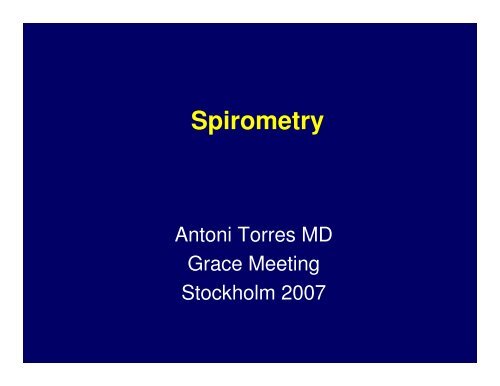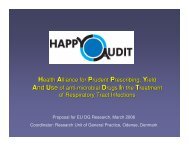Spirometry principles - Grace
Spirometry principles - Grace
Spirometry principles - Grace
You also want an ePaper? Increase the reach of your titles
YUMPU automatically turns print PDFs into web optimized ePapers that Google loves.
<strong>Spirometry</strong><br />
Antoni Torres MD<br />
<strong>Grace</strong> Meeting<br />
Stockholm 2007
• Asessment of vital capacity and airflow are<br />
based on the forced expiratory volume<br />
manever in wich the subject inhales<br />
maximally to TLC, then exhales forcefully<br />
and completely to RV
• To obtain a satisfactory spirogram, the<br />
preceding inspiration must be maximal, and<br />
the forced expiratory volume maneuver<br />
must be continued to cessation of flow or,<br />
when emptying is slowed, for at least 6 to<br />
10 seconds
How to perform it?<br />
FVC:<br />
Minimum of 3 acceptable blows<br />
A rapid start is essential: this is defined as a back-extrapolated<br />
volume of 15 seconds; or stopped for<br />
clinical reasons<br />
Spirometer temperature between 17 and 40 degrees Celsius;<br />
measure spirometer temperature to one degree Celsius<br />
Use of nose clip is encouraged<br />
Sitting or standing<br />
Reproducibility: the highest and second highest FVC should agree<br />
to within 0.2L<br />
Largest VC or FVC is recorded
How to perform it?<br />
• FEV1 :<br />
• As for FVC<br />
• Take largest FEV1 even if not from the same curve as the<br />
best FVC<br />
• "Zero time" determined by back-extrapolation -<br />
extrapolated volume should be
Patient-Related Problems<br />
The most common patient-related problems when<br />
performing the FVC manoeuvre are:<br />
Submaximal effort<br />
Leaks between the lips and mouthpiece<br />
Incomplete inspiration or expiration (prior to or during the<br />
forced manoeuvre)<br />
Hesitation at the start of the expiration<br />
Cough (particularly within the first second of expiration)<br />
Glottic closure<br />
Obstruction of the mouthpiece by the tongue<br />
Vocalisation during the forced manoeuvre<br />
Poor posture.
Instrument-Related Problems<br />
These depend largely on the type of spirometer being<br />
used. On volume-displacement spirometers look for<br />
leaks in the hose connections; on flow-sensing<br />
spirometers look for rips and tears in the flowhead<br />
connector tube; on electronic spirometers be particularly<br />
careful about calibration, accuracy and linearity.<br />
Standards recommend checking the calibration at least<br />
daily and a simple self-test of the spirometer is an<br />
additional, useful daily check that the instrument is<br />
functioning correctly.
Resultant Information<br />
• 1-The traditional spirogram plots volume versus<br />
time, with the flow rate indicated by the steepness<br />
of the plot<br />
• 2-The flow-volume display, the flow rate is<br />
measured and plotted on the vertical axis, with<br />
volume in the horizontal axis. Time is not shown<br />
on this plot but may be indicated by tick marcks
Basic Measurements<br />
• Forced vital capacity (FVC)<br />
• FEV1: The forced expiratory volume in one<br />
second<br />
• Ratio FEV1/FVC
Other measurements<br />
• FEF 25-75: Is the averaged forced expiratory flow<br />
rate between 25-75% of the exhaled volume<br />
• FEV 0.5: Adds little diagnostic information<br />
• Peak flow rate: cannot be easily calculated<br />
• MVV: Maximal voluntary ventilation can be<br />
measured on some office spirometers but this test<br />
is primary a laboratory measurement
Prediction equations and limits of<br />
normality<br />
• Numerous prediction equations have been<br />
derived from spirometric surveys of normal<br />
populations (exclude all smokers and<br />
cardiothoracic illness)<br />
• Spirometric parameters can be predicted on<br />
the basis of gender, age and heigth<br />
• They use the lower limit of normal (LLN)
Different Patterns: obstructive<br />
• FEV1/FVC ratio below the LLN<br />
• Typically FVC is normal in the early course<br />
of the disease but is reduced in more severe<br />
disease<br />
• When FEV1/FVC ratio is low, even<br />
individuals with an FEV1 equal to 80% to<br />
100% of the predicted values are considered<br />
to have mild airflow obstruction
Different patterns: Restrictive<br />
• Classically there is a reduction in TLC<br />
(wich cannot be measured by spirometry)<br />
• Is inferred from spirometry when a matched<br />
decrement occurs in FEV1 and FVC so that<br />
the FEV1/FVC ratio is normal or high
Different patterns: Mixed<br />
• A reduced FVC together with a low FEV1/FVC%<br />
ratio is a feature of a mixed ventilatory defect in<br />
which a combination of both obstruction and<br />
restriction appear to be present, or alternatively<br />
may occur in airflow obstruction as a consequence<br />
of airway closure resulting in gas trapping, rather<br />
than as a result of small lungs. It is necessary to<br />
measure the patient's total lung capacity to<br />
distinguish between these two possibilities.
Bronchodilator response<br />
• <strong>Spirometry</strong> is repeated after 15 min of the<br />
administration of beta-agonist or 30 min after<br />
ipratropium bromide<br />
• An increase in 12-15% in the FEV1 represents a<br />
significant response in an individual who has a<br />
near normal spirometry<br />
• With more severe obstructive disease the<br />
magnitude of improvement should be at least 200<br />
mL<br />
• Because its large variability the improvement in<br />
FEF 25-75 has to be of 30 to 40%.




